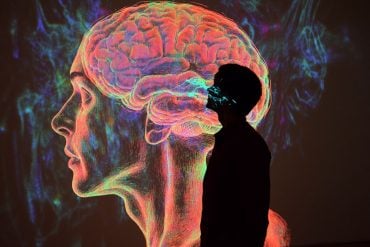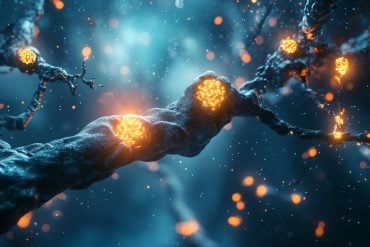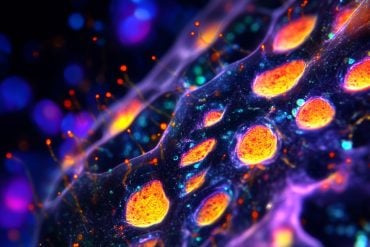Summary: NIH researchers have identified a set of genes they believe could explain why some people need more, or less, sleep that others. The findings could help to develop new treatments for a variety of sleep disorders from insomnia to narcolepsy.
Source: NIH.
Scientists have identified differences in a group of genes they say might help explain why some people need a lot more sleep–and others less — than most. The study, conducted using fruit fly populations bred to model natural variations in human sleep patterns, provides new clues to how genes for sleep duration are linked to a wide variety of biological processes.
Researchers say a better understanding of these processes could lead to new ways to treat sleep disorders such as insomnia and narcolepsy. Led by scientists with the National Heart, Lung, and Blood Institute (NHLBI), part of the National Institutes of Health (NIH), the study will be published on Dec. 14 in PLOS Genetics.
“This study is an important step toward solving one of the biggest mysteries in biology: the need to sleep,” says study leader Susan Harbison, Ph.D., an investigator in the Laboratory of Systems Genetics at NHLBI. “The involvement of highly diverse biological processes in sleep duration may help explain why the purpose of sleep has been so elusive.” Scientists have known for some time that, in addition to our biological clocks, genes play a key role in sleep and that sleep patterns can vary widely. But the exact genes controlling the duration of sleep and the biological processes that are linked to these genes have remained unclear.
To learn more, scientists artificially bred 13 generations of wild fruit flies to produce flies that were either long sleepers (sleeping 18 hours each day) or short sleepers (sleeping 3 hours each day). The scientists then compared genetic data between the long and short sleepers and identified 126 differences among 80 genes that appear to be associated with sleep duration. They found that these genetic differences were tied to several important developmental and cell signaling pathways. Some of the genes identified have known functions in brain development, as well as roles in learning and memory, the researchers said.

“What is particularly interesting about this study is that we created long- and short-sleeping flies using the genetic material present in nature, as opposed to the engineered mutations or transgenic flies that many researchers in this field are using,” Harbison said. “Until now, whether sleep at such extreme long or short duration could exist in natural populations was unknown.”
The researchers also found that the lifespan of the naturally long and short sleepers did not differ significantly from the flies with normal sleeping patterns. This suggests that there are little physiological consequences — whether ill effects or benefits — of being an extreme long or short sleeper, they said.
Funding: The study was funded by the Intramural Research Program (IRP) of the NHLBI.
Source: NIH
Publisher: Organized by NeuroscienceNews.com.
Image Source: NeuroscienceNews.com image is in the public domain.
Original Research: Full access research for “Selection for long and short sleep duration in Drosophila melanogaster reveals the complex genetic network underlying natural variation in sleep” by Susan T. Harbison, Yazmin L. Serrano Negron, Nancy F. Hansen, Amanda S. Lobell in PLOS Genetics. Published online December 14 2017 doi:10.1371/journal.pgen.1007098
[cbtabs][cbtab title=”MLA”]NIH “To Sleep or Not to Sleep: The Complex Genetic Network Behind Sleep Duration.” NeuroscienceNews. NeuroscienceNews, 15 December 2017.
<https://neurosciencenews.com/genetics-sleep-duration-8193/>.[/cbtab][cbtab title=”APA”]NIH (2017, December 15). To Sleep or Not to Sleep: The Complex Genetic Network Behind Sleep Duration. NeuroscienceNews. Retrieved December 15, 2017 from https://neurosciencenews.com/genetics-sleep-duration-8193/[/cbtab][cbtab title=”Chicago”]NIH “To Sleep or Not to Sleep: The Complex Genetic Network Behind Sleep Duration.” https://neurosciencenews.com/genetics-sleep-duration-8193/ (accessed December 15, 2017).[/cbtab][/cbtabs]
Abstract
Selection for long and short sleep duration in Drosophila melanogaster reveals the complex genetic network underlying natural variation in sleep
Why do some individuals need more sleep than others? Forward mutagenesis screens in flies using engineered mutations have established a clear genetic component to sleep duration, revealing mutants that convey very long or short sleep. Whether such extreme long or short sleep could exist in natural populations was unknown. We applied artificial selection for high and low night sleep duration to an outbred population of Drosophila melanogaster for 13 generations. At the end of the selection procedure, night sleep duration diverged by 9.97 hours in the long and short sleeper populations, and 24-hour sleep was reduced to 3.3 hours in the short sleepers. Neither long nor short sleeper lifespan differed appreciably from controls, suggesting little physiological consequences to being an extreme long or short sleeper. Whole genome sequence data from seven generations of selection revealed several hundred thousand changes in allele frequencies at polymorphic loci across the genome. Combining the data from long and short sleeper populations across generations in a logistic regression implicated 126 polymorphisms in 80 candidate genes, and we confirmed three of these genes and a larger genomic region with mutant and chromosomal deficiency tests, respectively. Many of these genes could be connected in a single network based on previously known physical and genetic interactions. Candidate genes have known roles in several classic, highly conserved developmental and signaling pathways—EGFR, Wnt, Hippo, and MAPK. The involvement of highly pleiotropic pathway genes suggests that sleep duration in natural populations can be influenced by a wide variety of biological processes, which may be why the purpose of sleep has been so elusive.
“Selection for long and short sleep duration in Drosophila melanogaster reveals the complex genetic network underlying natural variation in sleep” by Susan T. Harbison, Yazmin L. Serrano Negron, Nancy F. Hansen, Amanda S. Lobell in PLOS Genetics. Published online December 14 2017 doi:10.1371/journal.pgen.1007098






